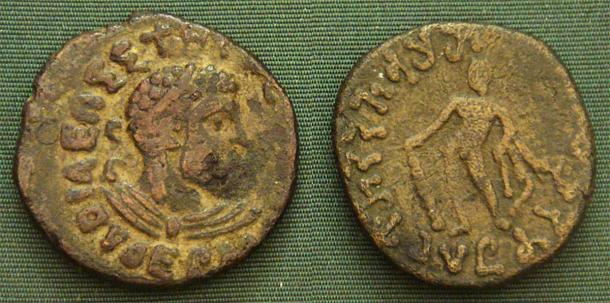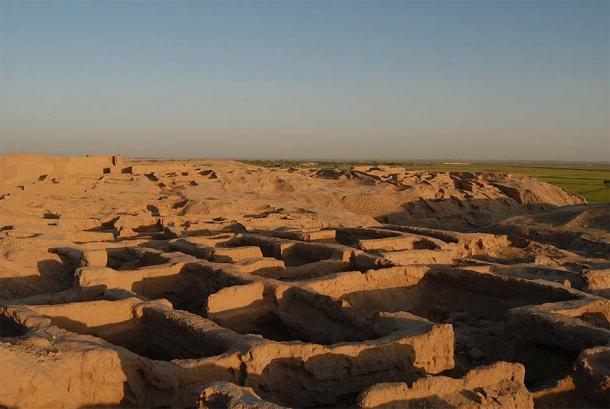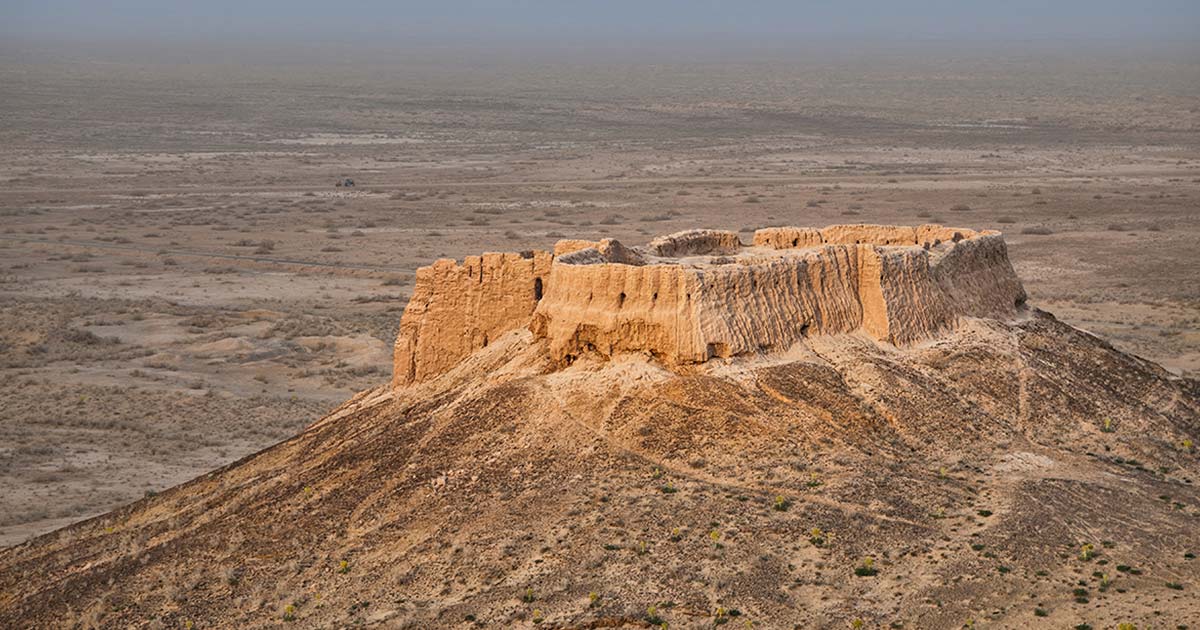Pax Kushana: Uncovering the Forgotten Kushan Empire
Nestled at the very core of ancient Central Asian history lies the enigmatic Kushan Empire, a once-powerful civilization that flourished during the critical centuries of the Common Era. Stretching its influence across the arid landscapes of modern-day Uzbekistan, Afghanistan, Pakistan and parts of northern India, the Kushan Empire emerged as a cultural and commercial crossroads, weaving together the rich threads of East and West along the ancient Silk Road.
For more than 200 years the Kushan Empire existed in relative peace, bringing about a period of peace and prosperity that would later be known as Pax Kushana. Even so, the empire fragmented and disappeared. What was its history like? And who were the Kushans who made it all happen?
The Kushan Empire and It’s Stellar Rise
The early origins of the Kushan Empire are intricately tied to the migratory patterns and geopolitical dynamics of Central Asia during the 1st century AD. The Kushans were believed to be descendants of the enigmatic Yuezhi, a nomadic people who faced displacement from their original homeland, possibly in the region of present-day western China. These migrations, driven by a complex mix of factors including pressure from neighboring tribes and the lure of new territories, set the stage for the gradual rise of the Kushan Empire.
- Extraordinary Buddhist Sculptures Unearthed in the Ruins of an Ancient City in Pakistan
- 2,000-Year-Old Unknown Kushan Language Is Finally Deciphered
Under the leadership of Kujula Kadphises, a prominent figure among the Yuezhi, a consolidation of power and authority began to take shape in the region. Kujula Kadphises not only unified various Yuezhi tribes but also demonstrated astute political acumen by forging alliances with neighboring groups. This consolidation marked the initial stages of the Kushan Empire, as it evolved from a confederation of nomadic tribes into a more centralized and organized political entity.
The Yuezhi's migratory journey westward brought them into contact with different cultures and civilizations along the Silk Road, contributing to a rich tapestry of influences that would characterize the Kushan Empire. As the Kushans expanded their territorial reach, they encountered Hellenistic and Persian influences from the west and the diverse cultures of Central Asia, creating a unique blend that would later manifest in the empire's art, culture, and governance.
Kujula Kadphises' successors, particularly his son Vima Takto, played pivotal roles in solidifying the nascent empire. Vima Takto's reign marked an important period of territorial expansion, laying the groundwork for the Kushan Empire's emergence as a major player in Central Asia. These formative years set the stage for the subsequent chapters of Kushan history, marked by the reigns of notable rulers such as Kanishka the Great, whose contributions would further elevate the empire's stature and influence in the centuries to come.
“His son, Yangaozhen [probably Vema Tahktu or, possibly, his brother Sadaṣkaṇa], became king in his place. He defeated Tianzhu [North-western India] and installed Generals to supervise and lead it. The Yuezhi then became extremely rich. All the kingdoms call [their king] the Guishuang [Kushan] king, but the Han call them by their original name, Da Yuezhi [Great Yuezhi].”

Coin of Kujula Kadphises, the first emperor of the Kushan Empire. (Public domain)
Setting Up the Foundations of an Empire
The Kushans are for the most part a historical enigma. Their identity is largely a mystery, although it is commonly agreed that they were of Indo-European provenance, possibly related to the ancient Tocharians of the Tarim Basin, or a mixture of Iranian and Indo-European peoples. Nevertheless, it is accepted that they were a part of the Yuezhi Confederation, the mention of whom is known to us from ancient Chinese writings.
As these tribes moved westwards towards the Bactrian region, displacing other peoples before them, the gradual spread of the Kushan territories began, forming into a vast empire. The geographical extents of the Kushan Empire encompassed a strategic and diverse expanse of Central Asia and northern India. The empire's territorial reach evolved over time, reflecting the military conquests and political dynamics of its rulers.
The core regions of the Kushan Empire included:
- Bactria, the heartland of the Kushan Empire and an ancient region corresponding to parts of modern-day Afghanistan, Uzbekistan, and Tajikistan. Bactria served as a crucial crossroads for trade and cultural exchanges along the Silk Road.
- Gandhara, which includes parts of modern Pakistan and eastern Afghanistan. Gandhara became a significant center for artistic and cultural developments, especially in the creation of the distinctive Gandhara art that fused Hellenistic and Indian styles.
- Northern India, incorporating territories that now form parts of modern-day northern India, including regions around Mathura and Taxila. These areas became integral to the empire's economic and cultural activities.
- Central Asian Corridor, where the Kushans maintained a strategic presence, facilitating trade and interactions between the East and West. This geographical positioning allowed the empire to capitalize on the lucrative commerce along the Silk Road.
The capital cities of the Kushan Empire shifted over time, reflecting the strategic and administrative needs of the rulers. Initially established at Kapisa (modern Bagram, Afghanistan), the capital was later moved to Purushapura (modern Peshawar, Pakistan), indicating the southward expansion of the empire. The geographical extents of the Kushan Empire made it a melting pot of diverse cultures and religions.
The empire's ability to control key trade routes contributed to its prosperity and played a crucial role in the transmission of ideas and goods across different civilizations. However, this vast territorial expanse also presented challenges in terms of governance and defense, factors that influenced the empire's historical trajectory.

Gold coin depicting Kanishka I, or Kanishka the great, emperor of the Kushan Empire at the time of its zenith. (Public domain)
Culture, Art, and Religious Freedom within the Kushan Empire
The Kushan Empire was characterized by a remarkable fusion of diverse cultural and religious influences, creating a unique tapestry that reflected the empire's position as a crossroads between East and West. Most importantly, the Empire facilitated the melding of Hellenistic, Persian and Central Asian traditions.
The notable artistic style known as Gandhara art emerged during the Kushan period, showcasing a harmonious blend of Greek and Indian artistic elements. This distinctive art form is best exemplified by the creation of sculptures and reliefs that often depicted Buddhist themes.
One of the notable features of the Kushan Empire was its religious tolerance. The rulers, including Kanishka the Great, were known for embracing and promoting multiple religious traditions within their realm. Zoroastrianism, the indigenous belief systems of Central Asia, and various local deities were respected alongside the flourishing of Buddhism.

Statue of a bodhisattva dated to 131 AD inscribed with “Year 4 of the Great King Kanishka.” Kanishka the Great was one of the rulers of the Kushan Empire. (TravelBear71 / CC BY-SA 2.0)
This atmosphere of religious pluralism allowed diverse communities to coexist within the empire. Even the pantheon of the Kushan Empire reflected this, as it included gods from all major religions, such as Ahura Mazda, Mithras, Zeus, Hephaistos, Serapis, Buddha, Shiva and many others.
Perhaps the most enduring religious legacy of the Kushan Empire was its impact on Buddhism. Under the patronage of rulers like Kanishka, Buddhism not only flourished but underwent significant developments. Kanishka is traditionally associated with the convening of the Fourth Buddhist Council, which marked the formalization of the Mahayana tradition within Buddhism.
This movement emphasized new scriptures and expanded the pantheon of Buddhas and bodhisattvas. The Kushan Empire thus served as a conduit for the transmission of ideas and cultural practices across different regions. Buddhist missionaries and scholars, in particular, traveled along the Silk Road, disseminating Buddhist teachings and contributing to the exchange of knowledge.
And it wasn’t just religion that flourished. The Kushans were patrons of the arts, and their cultural influence is vividly expressed in the architecture and artifacts of the period. Cities like Mathura and Taxila became centers of artistic expression, producing sculptures and structures that reflected the synthesis of diverse cultural elements.

Seated Atlas, a relief of the Kushan Empire on display at Tokyo National Museum. (Public domain)
The Swift Rise and the Swift Decline of the Kushan Empire
The decline of the Kushan Empire was a complex process influenced by a combination of internal and external factors, leading to the gradual unraveling of its once-mighty influence. The empire started strong, under the skilled reigns of Emperors Vima Takto (90 to 113 AD), and his successor, Vima Kadphises (113 to 127 AD).
After him came Kanishka the Great (127 to circa 151 AD), during whose reign the Empire reached its zenith. But his grandson Vasudeva (190 to 230 AD) was considered the last great Kushan emperor, and likely faced threats of new outside enemies. It was exactly this that led to the gradual downfall of the mighty but short-lived Kushan Empire - new enemies.
From the west came Sasanian Persians, the Indian Guptas came from the east, and Hun tribes threatened from the North. In the mid-3rd century AD, the Sassanians, under the leadership of Shapur I, invaded and seized control of significant portions of the Kushan territory. These invasions strained the empire's ability to maintain its territorial integrity.
Matters were not helped by the internal struggles within the Empire that preceded the invasion, most notably succession disputes that weakened the stability of the Kushan Empire. Competing claims to the throne often resulted in conflicts among rival factions, diverting attention and resources away from external threats.
Changes in trade routes and economic dynamics may also have contributed to the economic decline of the Kushan Empire. The Silk Road, a vital artery for the empire's prosperity, underwent shifts that could have negatively impacted the Kushans' economic strength. Also taken into account are continued migrations of peoples, who sought new lands to settle.
Nomadic invasions from the north, possibly by the Kidarites and the Hephthalites (White Huns), further destabilized the Kushan Empire. These nomadic groups, who had been displaced themselves, posed significant military challenges and contributed to the fragmentation of the empire. As a result of all these conflicts and external pressures, the Kushan Empire gradually fragmented into smaller, semi-autonomous regions. Local rulers asserted their independence, and the centralized authority of the Kushans quickly waned.

Kampir Tepe archaeological site in Uzbekistan, is all that remains of what was once a fortress and mud brick city and one of the most complete settlements of the Kushan Empire ever found. (Stephanieadams99 / CC BY-SA 4.0)
The Fading of a Once-Great Realm
By the mid-4th century AD, the once-great Kushan Empire had largely disintegrated. The vacuum left by its decline was filled by emerging regional powers, such as the Gupta Empire in India and various Iranian and Central Asian entities. The legacy of the Kushan Empire persisted in the cultural, religious and artistic developments that it had fostered, but the political entity itself faded into history, leaving behind the remnants of a once-dynamic and cosmopolitan civilization.
- Samarkand: An Ancient Link Between East and West
- 2,000-Year-Old Coin Hoard Unearthed at Buddhist Stupa at Mohenjo-Daro!
For a time, remnants of the Kushan rulers persisted as “Little Kushans,” ruling locally in the Punjab area, having their capital at the ancient city of Taxila. Several Little Kushan kings are known, and they were likely vassals of India’s Gupta rulers. In time, however, even the last remnants of the Kushans faded into obscurity, and by the end of the 5th century AD, they no longer existed.
Thus ended a history of an enigmatic Central Asian civilization. The lack of inscriptions from the Kushans themselves meant that much of their history and identity remains somewhat of an enigma. The main source for studying their history are the writings of their neighbors, most notably the ancient Chinese. Even so, the achievements made by this short-lived empire are nothing short of stellar. Even centuries after their disappearance, the Kushans continue to captivate scholars, historians and enthusiasts alike.
Top image: Ayaz Kala in northern Uzbekistan was used by the Kushan Empire as a garrison. Source: bbsferrari / Adobe Stock
References
Avari, B. 2007. India: The Ancient Past. Routledge.
Dabrowa, E. 2015. Central Asia and Iran: Greeks, Parthians, Kushans and Sasanians. Jagiellonian University Press.
Grousset, R. 1970. The Empire of the Steppes: A History of Central Asia. Rutgers University Press.

















